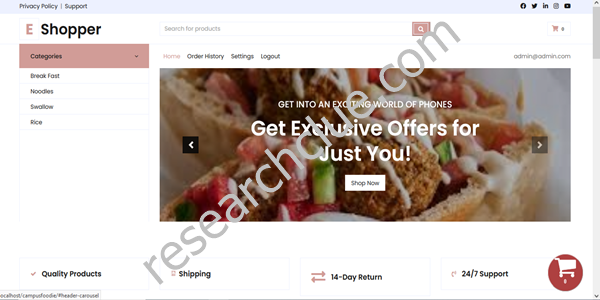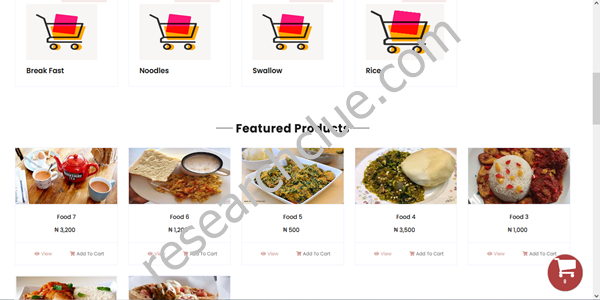ABSTRACT
The paper examines Design and Implementation of an online campus food ordering and delivery system (A case study of University of Lagos). Considering the numerous challenges campuses face in advertising food services offered to campuses to students and lecturers in an effective manner, the paper aims at developing a secure and convenient management system where students and other vendors on campuses can showcase their canteen services in real time. Considering technology used in implementing this work, the researcher used HTML, CSS, SQL and PHP. These technologies were considered because of its robust and simplicity in solving complex issues faced by many campuses in Nigeria.
CHAPTER ONE
INTRODUCTION
1.1 Background to the Study
The design and implementation of an online campus food ordering and delivery system represent a significant innovation in addressing the dining needs of students, faculty, and staff within educational institutions. In today's fast-paced world, the convenience of digital platforms has revolutionized the way individuals access food services, offering efficiency, flexibility, and accessibility. This introductory discussion aims to explore the key considerations and challenges involved in developing such a system, along with its potential benefits for enhancing the overall campus dining experience.
Traditional campus dining experiences often involve long queues, limited options, and time-consuming processes, leading to dissatisfaction among stakeholders. By introducing an online food ordering and delivery system, educational institutions can streamline the dining process, allowing users to browse menus, place orders, and make payments conveniently from their smartphones or computers. This not only saves time but also enhances the overall efficiency of food service operations, leading to greater satisfaction and improved productivity among students and staff (Gopalakrishnan & Rao, 2020).
One of the key advantages of an online campus food ordering and delivery system is the ability to offer customized and personalized dining experiences. Users can select from a diverse range of menu options, including dietary preferences, allergen information, and special requests, ensuring that their individual needs are met. Additionally, the system can track user preferences and ordering history, allowing for personalized recommendations and promotions tailored to each user's preferences. This level of customization not only enhances user satisfaction but also fosters loyalty and repeat business (Fernandes et al., 2019).
Successful implementation of an online campus food ordering and delivery system requires seamless integration with existing campus infrastructure and collaboration with food service providers. This involves establishing partnerships with local restaurants and vendors, integrating payment gateways and delivery logistics, and ensuring compatibility with campus-wide information systems. By leveraging existing resources and fostering collaboration among stakeholders, educational institutions can maximize the effectiveness and sustainability of the online food ordering and delivery system (Chen et al., 2020).
An important consideration in the design and implementation of an online campus food ordering and delivery system is ensuring accessibility and inclusivity for all users, including those with disabilities or special needs. This involves implementing features such as alternative text for images, keyboard navigation, and voice-enabled commands to accommodate users with diverse abilities. By prioritizing accessibility and inclusivity, educational institutions can create a more equitable dining experience for all members of the campus community, reinforcing their commitment to diversity and inclusion (Abou-Zeid et al., 2019).
1.2 Statement of the Problem
The design and implementation of an online campus food ordering and delivery system address several key challenges inherent in traditional campus dining experiences. Despite the convenience and variety of options available, students often face long lines, limited operating hours, and a lack of flexibility in meal choices within campus dining facilities. Moreover, the emergence of busy academic schedules and the desire for healthier, customizable meal options highlight the need for a more efficient and user-friendly food ordering system tailored to the campus environment. This problem statement aims to identify and explore the specific issues that such a system seeks to address, paving the way for the development of an innovative solution that enhances the dining experience for students while optimizing operational efficiency for campus food vendors.
- Traditional campus dining experiences often involve long queues and wait times, particularly during peak hours, leading to frustration and inconvenience for students with tight schedules. Additionally, limited operating hours may restrict access to food options outside of regular meal times, posing challenges for students with varied schedules or those engaged in extracurricular activities. Addressing these accessibility issues requires the implementation of an online food ordering and delivery system that provides students with convenient access to a diverse range of food options from campus vendors at any time of day.
- Another challenge faced by students in traditional campus dining settings is the lack of variety and customization options available in pre-packaged meals or limited menu selections. Many students have dietary preferences, restrictions, or specific cultural or religious dietary requirements that may not be adequately accommodated by existing dining options. Designing an online food ordering system allows for greater flexibility and customization, enabling students to select from a wider range of cuisines, dietary preferences, portion sizes, and ingredient choices tailored to their individual preferences and nutritional needs.
1.3 Objectives of the Study
The main objective of the study is to examine Design and Implementation of an online campus food ordering and delivery system (A case study of University of Lagos). Specific objectives of the study are:
- To design a well-structured and optimized database management system to store, process and retrieve user and canteen services information in real-time.
- To design and Implement a secure management information system not prone to internal and external attacks.
- To create a fast query system where customers can search for food vendors and place orders within their campus in real-time.
- To proffer solutions to the challenges and enhance already existing systems in place.
SCREEN SHOTS OF THE APPLICATION


1.4 Significance of the Study
The study is important for many reasons. The following are the major stakeholders this paper through its practical and theoretical implications and findings will be of great significance:
Firstly, the paper will benefit major stakeholders and policy makers in the Information Technology sector. The various analysis, findings and discussions outlined in this paper will serve as a guide in enabling major positive changes in the industry and sub-sectors.
Secondly, the paper is also beneficial to the organizations used for the research. Since first hand data was gotten and analysed from the organization, they stand a chance to benefit directly from the findings of the study in respect to their various organizations. These findings will fast track growth and enable productivity in the organisations used as a case study.
Finally, the paper will serve as a guide to other researchers willing to research further into the subject matter. Through the conclusions, limitations and gaps identified in the subject matter, other student and independent researchers can have a well laid foundation to conduct further studies.
1.7 Scope of the Study
The study is delimited to the University of Lagos. Findings and recommendations from the study reflects the views and opinions of respondents sampled in the area. It may not reflect the entire picture in the population.
1.8 Limitations of the Study
The major limitations of the research study are time, financial constraints and delays from respondents. The researcher had difficulties combining lectures with field work. Financial constraints in form of getting adequate funds and sponsors to print questionnaires, hold Focus group discussions and logistics was recorded. Finally, respondents were a bit reluctant in filling questionnaires and submitting them on time. This delayed the project work a bit.
1.9 Organization of the Study
The study is made up of five (5) Chapters. Chapter one of the study gives a general introduction to the subject matter, background to the problem as well as a detailed problem statement of the research. This chapter also sets the objectives of the paper in motion detailing out the significance and scope of the paper.
Chapter Two of the paper entails the review of related literature with regards to corporate governance and integrated reporting. This chapter outlines the conceptual reviews, theoretical reviews and empirical reviews of the study.
Chapter three focuses on the methodology and analysis of the existing system. This gives an insight into the analysis of systems in place already, facts finding sources, input analysis, output analysis, process analysis and objectives of the new system to be implemented.
Chapter Four focuses on the Analysis of the New system to be Implemented, the design standard, output specification and design, input specification and design, system flow chart and requirements.
Chapter Five outlines the findings, conclusions and recommendations of the study. Based on objectives set out, the researcher concludes the paper by answering all research questions set out in the study.
1.10 Definition of Terms
- Online Campus Food Ordering and Delivery System: A digital platform designed to facilitate the ordering, payment, and delivery of food items from campus dining facilities to students, faculty, and staff within a university or college campus environment. This system typically includes features such as online menus, order customization, payment processing, order tracking, and delivery logistics to enhance the convenience and accessibility of campus dining options.
- User Interface (UI): The graphical interface through which users interact with the online campus food ordering and delivery system. UI design focuses on creating intuitive, visually appealing layouts and navigation structures that facilitate seamless user interaction and enhance the overall user experience.
- User Experience (UX): The overall experience and satisfaction of users when interacting with the online campus food ordering and delivery system. UX design encompasses factors such as ease of use, efficiency, accessibility, and satisfaction, with the goal of optimizing user engagement and achieving user-centered design outcomes.
- Menu Management: The process of creating, updating, and managing the digital menus offered by campus dining facilities within the online ordering system. Menu management involves categorizing food items, setting prices, specifying descriptions and ingredients, and incorporating images to provide users with comprehensive and visually appealing menu options.
- Payment Gateway: A secure online platform integrated into the online campus food ordering and delivery system to facilitate electronic payment transactions. Payment gateways enable users to securely enter payment information, such as credit card details or digital wallet credentials, and process payments for their food orders in real-time.
- Order Fulfillment: The process of preparing, packaging, and delivering food orders placed through the online campus food ordering and delivery system. Order fulfillment involves coordinating with campus dining facilities, kitchen staff, delivery personnel, and logistics providers to ensure timely and accurate delivery of food items to customers.
